Galapagos: Well Worth a Visit Despite the Expense
It’s expensive to visit and the number of places you can anchor are severely restricted – but … it’s the Galapagos and well worth the time, money and effort to visit, according to Maryanne and Kyle Webb who visited in early 2025. In this report Maryanne provides some helpful information for cruisers who may be considering visiting this unique and isolated island chain.
Published 5 months ago
It’s the Galapagos!
It’s expensive and the anchorages you can visit are restrictive – but … it’s the Galapagos!
Using an Agent is compulsory for visiting boats and requires payment and paperwork to be organized prior to your arrival.
We visited all the four permitted islands with our own boat – and there is much overlap in what we were able to enjoy – but each island did have a little something special and its own character, so we have no regrets on that front.
It will help if you can speak some Spanish. (Or at least carry a good translation app with you – we love Google Translate which also allows you to download in advance any language for offline use).


Rules and Regulations
[See Noonsite’s Galapagos Formalities for the full details]
- You are not permitted to take your own boat or dinghy to explore, snorkel or dive at various spots. You must only anchor at one of the four specified island ports and then take a tour to visit the permitted sites around the coast and islands.
- Technically you can pay extra to visit MANY other sites with your own boat – but this must be organised well in advance, it is very expensive and requires you also have a park guide aboard the boat at all times. So this is generally limited to mega yacht budgets.
- You are not permitted to use your own Kayaks, Stand Up Paddleboards, or to use a drone (it is advisable to keep them stowed away).
- AIS transmission is mandatory (at least when underway within Galapagos waters). If you don’t have one – you will be expected to rent one on arrival.
- There are strict rules about signage aboard and how to manage your trash/recycling etc. Follow the instructions your agent gives you, so you are ready for inspection on arrival.
- If you have a boat stamp – the officials love that you use it (but it’s not required).
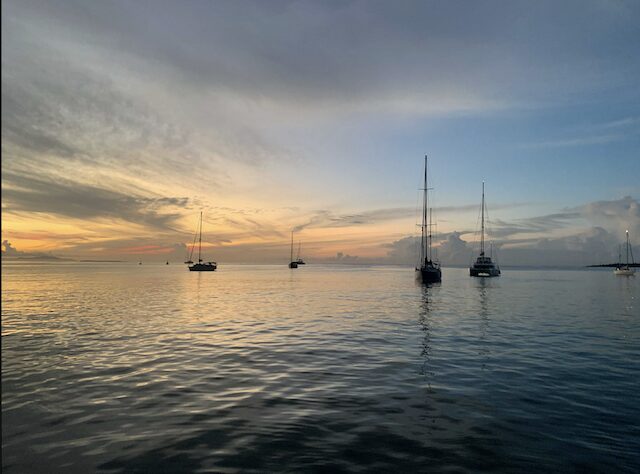

Cash and Credit Cards
It’s primarily a cash economy (US$) so bring plenty. ATMs are available in three of the main islands/towns, but not at Floreana. You may need to pre-notify your card provider that you will be in Ecuador.
Many businesses (bars, restaurants, tour companies) only take cash and they all prefer cash. Those limited bars, restaurants and tour providers that do allow credit card payments, may also charge a hefty fee (we were quoted anything from 0% to 18%) so factor that in when comparing costs. Never sit down to eat (or at a bar) before first verifying how you can pay.
The majority of ATMs limit withdrawals to $200 at a time for foreign card holders and the fee varies (but expect to pay around $5 on a $200 withdrawal). If your own bank has a bigger daily limit – you can make multiple $200 withdrawals one after the other on the same day from the same machine. There are reports of some ATM machines allowing greater withdrawal amounts, but I can’t confirm that. It may be easier to just bring plenty of cash with you ($US) – depending on where you are arriving from – but keep notes small (certainly avoid $100 bills for anything other than possibly tour bookings) or at least have a good range of bills. The $1 coin is widely used (unlike within the USA).
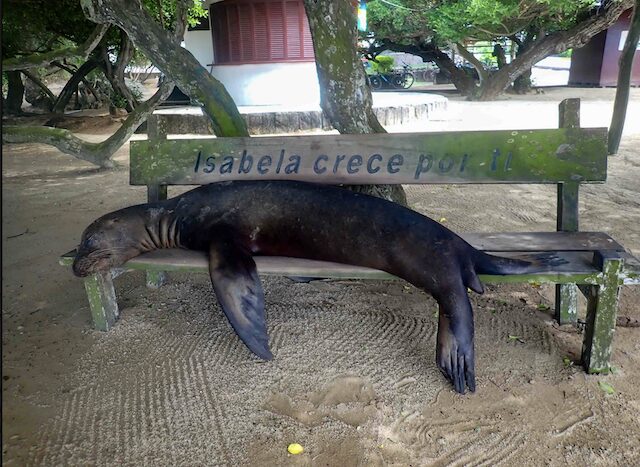

Fuel, Water and Trash
Fuel is expensive (US$5/gallon), must be organized through your agent (for a set amount) and paid for in cash on delivery to your boat – and since you can expect to have to motor between islands you should plan your needs. It may be worth organizing extra jerry cans or even a barrel of fuel before you depart for Galapagos (if you have the space).
Water can also be delivered to your boat ($0.50/gallon) – pay in cash. It rained daily during our stay (mostly at night, so not a real issue for sightseeing). We were able to collect rain-water readily.
Trash/recycling can be collected from the boat in some islands (US$3/bag). Or it is free to deposit in dumpsters at other islands (e.g. Isabela).
Sea Lions and Security
Sea Lions are present in all the four anchorages and use the boats to rest (San Cristobal being the most active for this). If you have a sugar scoop transom or have a catamaran with stern steps, then they can easily board your boat (but they can also jump many feet if they wish to reach a platform!). Use boards, fenders, buckets, etc. to keep them off your boat (or keep them to the rear steps only) as they will make an amazing mess (rinse off with sea water each morning to avoid the brown stains). In our case one managed to bypass our defences and made it to our cockpit and broke our cockpit table. They are huge/heavy creatures! The local boats use a combination of netting and razor wire to deter sea lions!
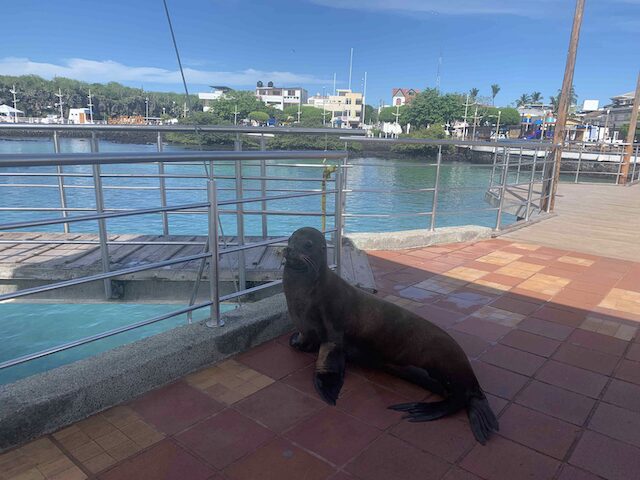

We always felt safe and had no security concerns ashore or for the boat – even leaving stuff unattended on the beach while snorkelling!
Tours and Tour Guides
There are a number of amazing tours available and many places can only be visited through an approved tour (with a park guide).
Tour prices vary by shop (for exactly the same tour) so it pays to ask/look around. Most stores do not accept credit cards (but some do and fees vary). We regularly saved between US$10 and US$40 per person/tour by shopping around for 30 minutes! There are some online tour businesses that you can pay by credit card – e.g. galapagosbluesky.com. This makes things convenient (and such sites can give you a good idea of what to expect and save you time), but it is often cheaper to book the same tour through a local office and pay cash.
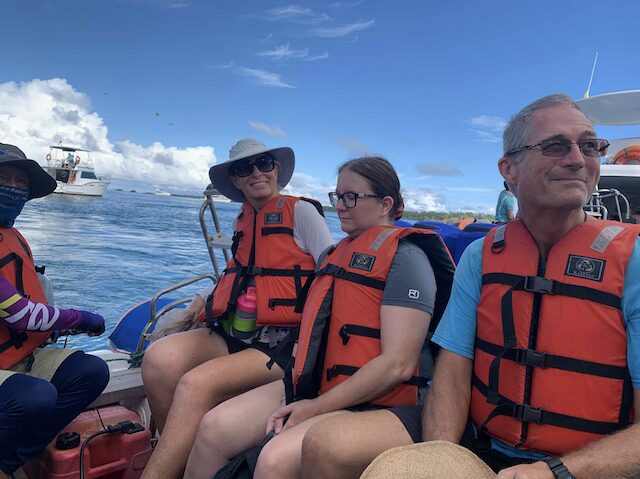

Some tourist and beach/snorkel sites are available to walk/cycle/bus/taxi to without an official guide (helps with the total expenses).
Sometimes an advertised/paid tour location can be reached without the need for a guide (and so much cheaper, but without the commentary) – ask your agent or tour operator. Walk/taxi/bus/bicycle options may exist depending on location.
The tour operators and park gatekeepers are required to collect your passport number – you don’t need to show your passport – just have the number(s) handy for when asked.
Tours involving snorkeling can be frustrating as you will need to keep with the group and many tourists are not the water babies that most cruisers are (mask problems, nervous in the water, etc.). Since we are used to snorkeling and exploring underwater alone, we found these crowd and time limits quite difficult – but such tours were still better than not going!
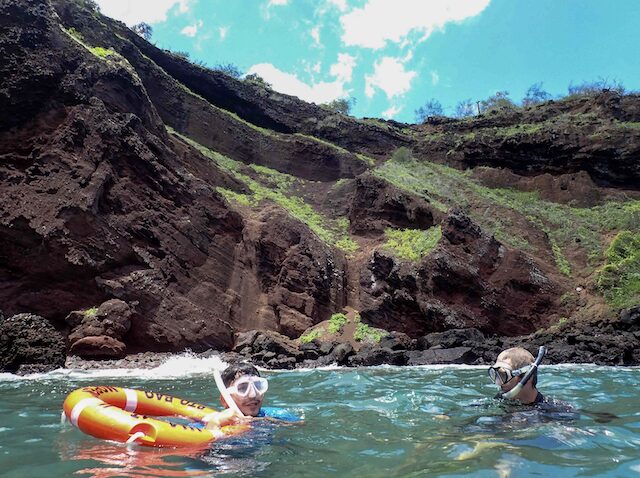

Most tours are with bilingual Spanish/English speaking guides.
Some locations offer kayak rentals and, depending on area, you can explore alone or may need a guided tour with an official park ranger.
Some cruisers organize for a local to look after the boat while they take a multi-day live-aboard cruise so they can see more areas. This is especially useful if you are a keen scuba diver. You may also get last minute deals on such trips if they have otherwise empty cabins!
The NoForeignLand app was really useful to us for planning and exploring (it is free and also has the option to download an area for offline use). It is a crowd sourced data set for cruisers.
All the snorkelling we did was over a rocky seabed, or sand; no coral reefs! But there are plenty of large fish, large schools of fish, and green turtles and you might also be underwater with sharks, rays, iguana, octopus, sea lions, penguins, and even sea horses depending on the site.


Rentals and Restaurants
No car or moped rentals to foreign nationals. Only bicycles (and e-bikes) are available to rent and prices vary dramatically between islands. Taxis and/or public buses may be an option too.
There are no chain restaurants or chain hotels in the islands. Vegetarian / vegan options are available at most restaurants and on tours where food is provided – but limited.
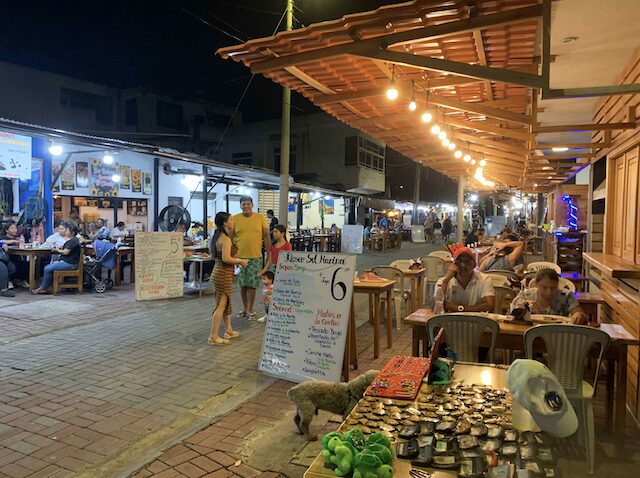

Shopping
Grocery shopping is very basic (stock up before you depart for Galapagos) – but there are also markets and small family farms where you can find a reasonable range of fresh provisions.
No low-cal/sugar-free/diet drinks found in stores or restaurants (aside from water).
Navigating/Anchoring
There is an (approximately) 1.5kt current pushing you (mostly) westward among the islands – so factor that in your planning as you move between islands.
Anchoring is at widely variable depths depending on the island) and check/allow for the tide range too. Some have complained about the “rolly-ness” of many of the anchorages.
All four islands offer a water taxi service (can call via VHF or in some cases WhatsApp) – hours and rates differ by port. In some islands you can use your dinghy ONLY to drop off (or collect) passengers ashore – in some you can use your dinghy as a tender to shore.
We chose to always use the water taxi. All islands charged US$1 per person per trip, except Isabela where the price is US$2.
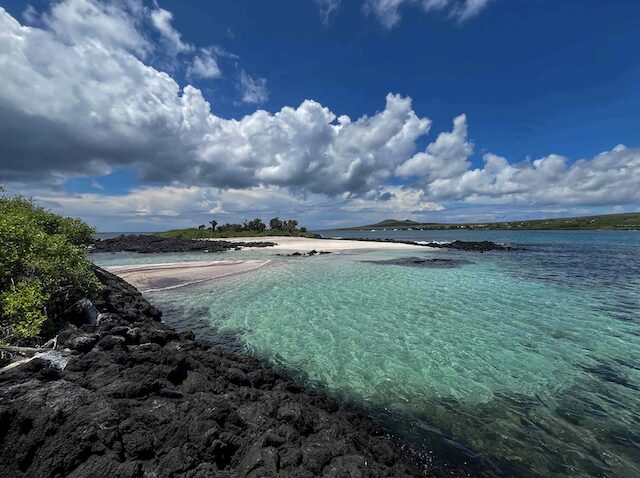

Other Useful Information
- Most beaches have no shade nor facilities (bring your own water and hats, etc.)
- Solar intensity can be extreme- so keep covered/protected.
- A few areas we visited had problematic flies or mosquitoes – if restaurants suffer they often have mosquito coils they will light under your table and deet-like spray you can use – so don’t suffer, just ask!
- Starlink for WiFi is now widespread among the Galapagos so you can expect to find high speed wifi ashore (restaurants, and even in some shore taxis and day-tour boats).
- WhatsApp is widely used by agents and businesses, etc.
- We needed to visit the hospital/clinic to address a throat infection – and were amazed at the speedy service and $0 bill for both consultation and medications!!!
Maryanne and Kyle Webb
SV Begonia
…………………………
About the Authors:
With a desire to actively “steer” their lives rather than safely continue on the conveyor belt of life, Maryanne and Kyle Webb merged their dreams and set out on a life of cruising the world more than 20 years ago. For many years their cruising was interrupted with periods based in one place to “stuff-the-kitty”, but since 2016 they have been full-time cruisers. They have already been around the world and are currently cruising through the atolls of French Polynesia.
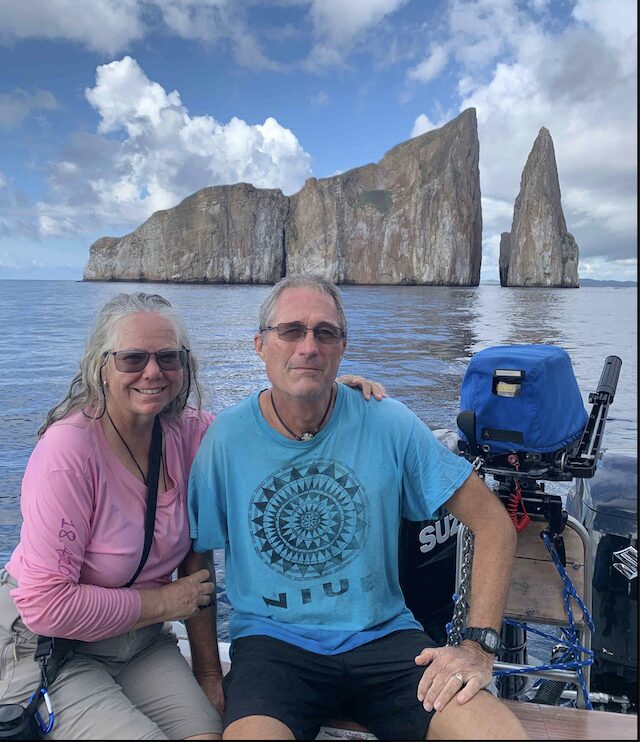

Read more about these cruisers;
- Portrait of a Cruiser – Maryanne and Kyle Webb
- More Noonsite reports from Maranne and Kyle Webb
- Follow their travels at SV Footprint & Begonia
…………………………………
© 2025 Noonsite. This content was edited by Noonsite. Do not reproduce without permission. All rights reserved.
The opinions expressed in this article are the author’s own and do not reflect the view of Noonsite.com or World Cruising Club.
Find out all news, reports, links and comments posted on Noonsite, plus cruising information from around the world, by subscribing to our FREE monthly newsletter. Go to https://www.noonsite.com/newsletter/.
Related to following destinations: Floreana, Galapagos, Isabela, Outer Islands (Galapagos), Puerto Ayora (Academy Bay), Puerto Baquerizo Moreno (Wreck Bay), Puerto Villamil, San Cristobal, Santa Cruz
Related to the following Cruising Resources: Anchorages, Circumnavigation, Circumnavigation, Cruising Information, Pacific Crossing, Pacific Ocean South, Planning and Preparation, Routing




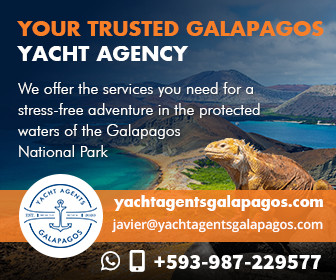
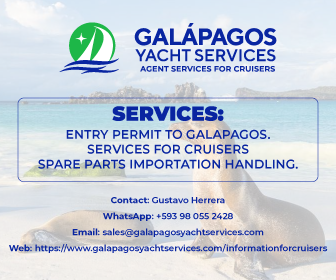
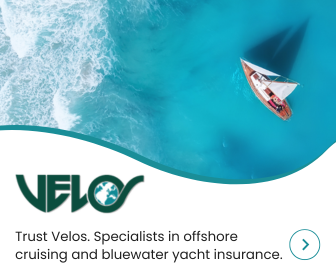
Visited the Galapogas from Ecuador about 8 years ago, not on my own boat but an organised 8 day cruise which included the use of a guide. I remember thinking then that for the expense of using my own boat and the restrictions that apply to it, it was a better option to get on an organised cruise from the likes of Panama/Ecuador and bypass the Galapagos whilst sailing on route to the likes of the Marquesas. However saying all that the Galapagos should not be missed but be aware it’s a heavily protected nature reserve not a Disney holiday destination where you come second to the animals and nature.
Very imformative, thank you!
Can you or anyone else reccomend a private guide? Especially for snorkeling !
Thanks!